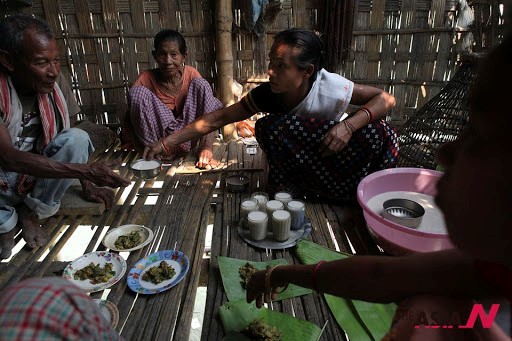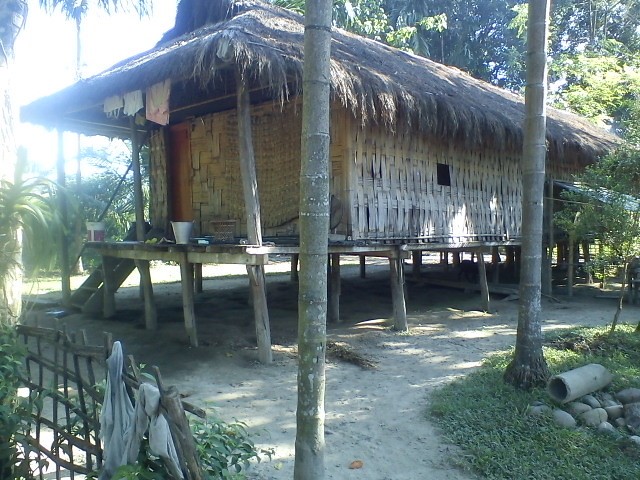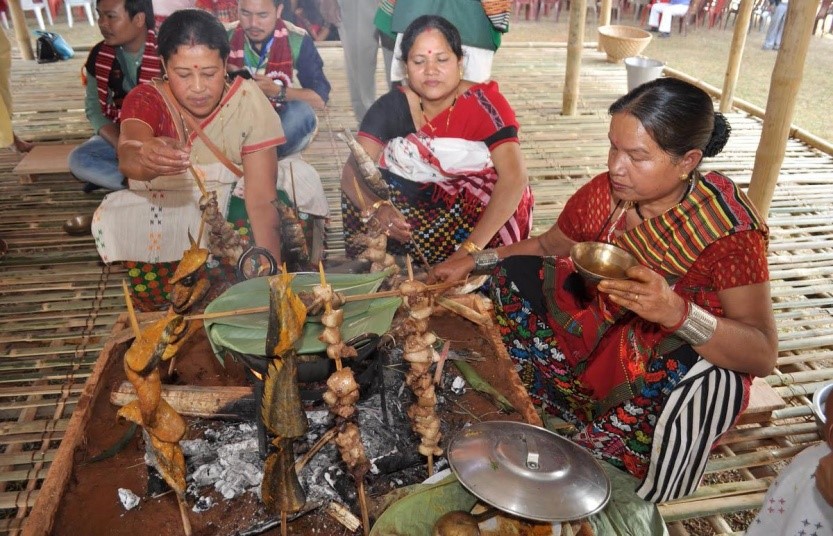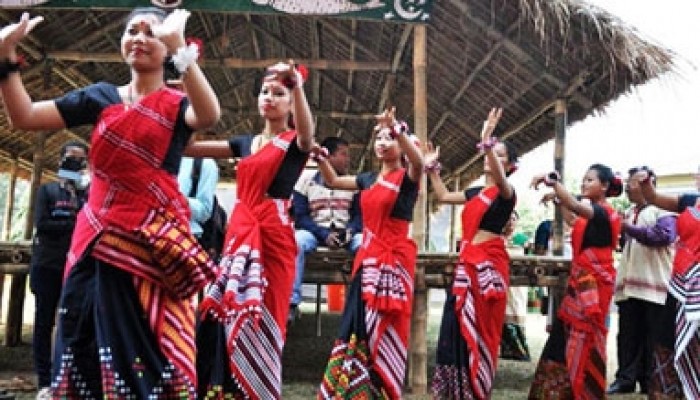Ali-ai-Ligang – A Beautiful Agricultural Festival of the Mising Janajatis of Assam Part-2
- In History & Culture
- 04:54 PM, Mar 10, 2021
- Ankita Dutta
No:gin (white-coloured) and Po:ro (black-coloured) are the two main varieties of Apong which are prepared for serving guests and visitors on the occasion of Ali-ai-Ligang. The stage-wise preparation of Apong is a lengthy and tedious process. It requires freshly-harvested rice and paddy husk which are fermented together with various locally available, traditional medicinal herbs beneficial for human health, e.g. flowers of gendelabon (goat weed), the tender leaf base of seni-bon (sweet broomweed), tezmooi (toothache tree), maati-kothal (pineapple), ising-okang (climbing bird’s nest fern), madhuriam (guava), bonjaluk (diamond flower), the tuberous roots of bhumi-champa (Indian crocus) and bhuin-komora (Indian kudzu), tezpat (Indian cassia lignea), etc. These are not only used in the preparation of Apong but also for healing wounds and tumours, curing toothache and gum problems, fever and cough, malaria, sinusitis, diabetes, high blood pressure, eye-problems, etc. But the increasingly reducing numbers of these plants of late, has become a cause of serious concern for the Misings whose socio-cultural identity is intertwined with these plants at many different levels.
A majority of the Misings in the Brahmaputra Valley are adherents of the Vaishnava naam-kirtan tradition of Srimanta Sankardeva. But Christianity is gradually making strong inroads among the Mising population of Majuli, Dhemaji, and Lakhimpur in Upper Assam since the last few decades. The impact of Christianity in the Mising society has been so overwhelming that a certain section of the community has completely given up the drinking of Apong and eating pork on the ground that the consumption of these food items is “sinful” and “polluting”! It is a serious threat to an entire culture and civilisation that is nature-centric and worships nature in all its manifestations.
Nevertheless, rice/dhaan is an indispensable item in the preparation of Apong. Rice straws are first burnt and then used to obtain chah-mod (ash liquor) which is smoky in colour. Very important guests are entertained by offering chah-mod. The rice straws are later used for the filtration of the Apong which appears a little faint-greenish in colour in the beginning. In all religious festivals of the Misings including Ali-ai-Ligang, the leaves of jagnya dimaru (cluster fig), marsang (Brazil cess), and mesaki (Duggal fibre tree) are used as the primary raw materials in the preparation of special curries, both vegetarian and non-vegetarian. They also believe that growing the two rarely found bhumi-champa (used in Apong) and nal-khagari (wild reed) plants inside the compound of their houses ahead of the Ali-ai-Ligang festival brings peace and harmony and also helps keep malevolent spirits at bay. There is a tradition among the Misings to use the water with which rice straws have been washed prior to the preparation of Apong for the treatment of stomach-related disorders among young kids.

A Mising family enjoying their Ali-ai-Ligang feast. Picture Credits: THE Asian
All the elder members of the household and visitors including near and dear ones, irrespective of age, gender and social status, etc. are served both Apong and Purang, along with rice, fish curry, and smoked pork. Feasting continues on all the five-six days of the festival. The head of the family again offers his prayers to their ancestors including Koje Yango (Goddess of Fertility) in the evening. It is a ritual among the Misings to lavishly pamper their elderly guests, friends, relatives, and neighbours with rice and Apong, as a mark of respect and obeisance. If by any chance Apong is not available, the Misings make use of tambula (areca-nut) and betel/paan leaves to welcome their guests. Both these items are considered as an offer of devotion, respect and friendship and are a part and parcel of the regional culture of Southern, Eastern and North-Eastern India. A special type of curry called Pitang Oying is prepared by the Misings from rice flour and chicken on the occasion. Sometimes, another variety called Koraiguri Oying is prepared from dried rice flour by the application of heat over a special bamboo container. On the third day of the festival, two different varieties of curry called Amin Oying (consisting of tiny broken rice particles cooked with or without fish or chicken) and Jabor Oying (a mix curry of either fish or chicken cooked in the leaves of different local vegetables) are especially served to the children and elderly in the family.
A special dish of chicken mixed with bamboo shoots and lentils (Baanhgajor logot kukura) is cooked in the community meals that are arranged as a part of the Ali-ai-Ligang festivities. Baked fish wrapped in banana leaves with white mustard paste is another popular delicacy. It is commonly known as Paatot diya maas, paat meaning leaf in Assamese. It is a customary ritual among different janajati communities of the Northeast to cook non-vegetarian dishes such as fish and meat on the leaves of different vegetables (e.g. ombe, pakkam, takak, dermi, etc.) during any religious ceremony or festival.
The dancing rituals begin with utmost joy after the feasting gets over. The cowherd boys are invited for the feast who later groove to the tunes of Gumrag. The entire village adorns a festive look and everyone gathers in the village field to celebrate, sing and dance with an ecstatic frenzy. The Mising Gumrag dance is accompanied by appropriate songs and represents a beautiful combination of different dance moves performed in a background of the continuous beating of drums and cymbals. Although it is performed in its own unique rhythm and style, the Gumrag dance of the Misings shares several similarities with the traditional dances of various other janajati communities in Assam such as that of the Dimasas, Rabhas, and Kacharis. The beauty and youth of the spring season that rejuvenates life again, is manifested at its optimum best by the young Mising boys and girls who take an active part in the community dancing activities. The romantic mood of the dance invokes their youthful instinct of love-making, marriage, and as well as the urge to procreate. It is a vivid expression of the exuberance of youth. A particular song called Lo:Le specifically associated with the Ali-ai-Ligang festival, is included in the Gumrag dance.
The dancers follow a pattern of rapid flinging, flapping and fluttering of hands, wrist movements, quick footsteps, and a rhythmic swaying of the hips wearing their traditional Mising attire with beautiful accessories. It is performed in honour of Ma Lakshmi on the first three days of Ali-ai-Ligang. The sensuous movements of this dance form gradually build up the tempo of love and romance. It is a time of courtships among young lovers who had always been working together in the fields and find an easy way for their childhood love to flourish during Ligang. Sometimes, these relationships also materialise into a life-long bond of marriage and commitment.
In a way, the Mising Gumrag dance is the most spectacular and dominant feature of the entire festival of Ali-ai-Ligang. It has almost become a mandatory norm for all the dancers who take part in the Gumrag dance to wear only hand-woven dresses as a symbol of their cultural pride and community identity. The dance has been noted for maintaining its authenticity while at the same time displaying the traditional Mising handlooms and handicrafts in all their beauty and glory. It usually lasts the entire night. Both boys and girls gracefully dance in a ring at every house in the village starting from the easternmost one which commonly happens to be the house of the village headman or the senior-most person in the village. The dancers ensure the fact that not a single house is spared in between. Their dance not only serves the purpose of entertainment for the locals but also holds a profound socio-religious importance in the Mising society. It pays a humble tribute to Mother Earth for all her bounty. It generally takes places in the open space encircling the courtyard outside every Sang-ghor/Okum of the Misings. These houses are built in twin-facing rows on a raised platform of a timber superstructure and thick bamboo stilts with wooden posts and beams, mainly as a measure of protection against wild animals and as well as the annual floods.

A typical Mising Okum
A typical Mising village is located on the banks of a river. It normally consists of 50-60 stilted houses having a flight of 5-7 stairs which are built on a bamboo frame at a certain height from the ground. Surrounded by lush green paddy fields, the Mising houses have thatched roofs and are generally connected to one another by walkways. The location of the Mising settlements is primarily determined by the availability of fish and water resources. No wonder, the Misings are well-known as the perfect fish-hunters in Assam!
The sounds of Ali-ali-ai and Ali-lai-ai could be heard in chorus from a distance as the young men and women dance in enthusiasm. The dancers are later treated to a sumptuous course of delicious lunch that includes Purang Apin, dried fish, and a curry of wild vegetables mixed with pork, followed by the ritualistic drinking of Apong. The dance later spreads towards the fields and the riverside by the evening. Young girls draped in attractive Mising mekhela-saadors (mekhela-saador is a traditional two-piece Assamese attire worn by women) and celebrating Ligang with full zest and vigour is a common sight across the Mising-dominated areas in the districts of Dhemaji, Lakhimpur, Dibrugarh, and Majuli in Upper Assam. They wear the mekhela (ege) or mosanam (skirt) as the lower garment from the level of the waist to the ankle, a saador (ri:bi gasong) as the upper garment with a bimbung (a type of Mising shawl) and a blouse together with a piece of cloth (gero segreg) that is tied around the waist on the top of the ege.
They are complimented with hand-made Assamese traditional jewellery and accessories popularly known as Axomiya Gohona, the most prominent of which include ear and neck ornaments (kentumaduli), chains (tadok), different types of bracelets (konge), etc. Red is the primary colour of the Mising community, and intricate designs of black, green and yellow woven in red are the standard feature of most of the Mising mekhela-saadors.
The males, on the other hand, wear a simple white dhoti (gongro ugon) as the lower garment, a sleeveless jacket (mibu-galuk) as the upper garment with a galuk (shirt) and a gonbor (a long loin cloth), a girdle (jinrek) tied at the waist over the dhoti and the jacket, a lingkab (a type of muffler) and a gamocha/colourful towel (dumer) tied as a turban on the head with a fluffy knot. Only a few of them use the turban (paguri). The gamocha looks like a white rectangular piece of cloth along with a red border on all the three sides and woven motifs at its two ends. An indispensable part of all socio-religious ceremonies in Assam, the gamocha can be said to be a symbolism of the life and culture of the state. There is another Mising group dance called Paksong Mo:man in which the villagers, both young and old, and male and female, actively take part. However, it is the young ones who first initiate the dance and the elder ones join in following the rhythmical tunes of the dhol (a twin-faced drum) and the taal (cymbals). Paksong Mo:man is a dance common to all the festive celebrations of the Misings and is performed at the backyard of their Okums.
Two other beautiful dance forms called Raktub So:man/Sa-man and Lotto So:man are performed by the adults of the community inside their houses during Ali-ai-Ligang. These common dance performances are an integral part of Ali-ai-Ligang. In fact, almost every religious ritual of the Misings is accompanied by a dance to propitiate their deities. Both dance and music constitute the two most important components of the cultural heritage of the Misings who collectively indulge in them on a variety of occasions like weddings, festivals, arrival of seasons, the birth of a baby in the family, and the harvesting of a new crop.
As mentioned earlier, the Ali-ai-Ligang celebrations continue for almost five-six days. The Misings observe a period of abstinence from agriculture-related works ranging from one to three days, and eventually end it through a brief religious ceremony called Yodlen Kunam. It calls upon nine different generations of their ancestors for blessing them with good health and wealth. This formally marks the end of Ali-ai-Ligang after which the people start devoting their time in the field for cultivation. Several similarities could be observed in the main celebrations of Ali-ai-Ligang with that of Rongali Bihu, e.g. bathing of cattle in the nearby ponds and rivers with special care and then feeding them in the evening, reading of verses from the Kirtan-Ghosha of Srimanta Sankardeva detailing the playful activities of Sri Krishna as a child, singing of Husori songs in chorus by a congregation of men in their neighbouring houses, etc. Groups of men form a band and go around the village singing different songs in their own Mising language while performing the dances and seeking blessings from the elders. The elders, in return, make an offering of betel-leaf and areca nut along with some money (orihona) and a gamocha (bastra-daan) as a token of love and appreciation.
A significant feature of Ali-ai-Ligang is the worship of the Bihu Devta on the last day of the festival known as Lilen, literally meaning “departing”. People who could not perform the ceremony of ancestor worship and lighting of the earthen lamps on the first day of the festival, for whatever reason, are socially expected to do it on this day. The spade which had been kept covered in the field and religiously at rest is uncovered by removing the leaves. The Mising farmer goes to the already sown field early in the morning and furrows it. In the afternoon, the field is levelled with the chanting of prayers to Bhudevi. The dancing and feasting celebrations continue for the next two days as well. Every year, one particular village is selected as the host village for the organisation of Lilen. It is enthusiastically celebrated with a lavish community feast called Dapan Tipan in the courtyards of the village homes of the host village. Villagers from the neighbouring villages are invited as guests to grace this last day of the festival. The feast includes Apong, dried fish, and pork as the main delicacies which are savoured with boiled rice.

Ali-ai-Ligang community feast. Mising women cooking smoked pork. Picture Credits: G Plus
Young Mising boys and girls raise a dais to the murti of the Bihu Devta in a nearby forest and plant a sapling of the silk-cotton tree (Salamali) alongside. Among the Misings, the silk-cotton tree is believed to symbolise an eternal life of good health, wealth and prosperity. The unique bond of cultural unity that connects different regions of this vast country into one single entity can be understood from the fact that in a few other parts of India such as Chhattisgarh and Odisha, games such as hide-and-seek are played around this same Salamali tree during any festival or religious event.
Flowers are showered in reverence for the Devta and the group of young men and women dance around it till almost late into the night. An earthen lamp is lit on the dais before the ceremony formally comes to an end. Prayers are offered to the Bihu Devta along with a token amount of money before everyone retires for the night. The ritual is that no one should look behind as he/she leaves the place, because it is supposed to bring mental dissatisfaction both at the home and professional fronts. Nowadays, due to urbanisation and the consequent lack of availability of enough space, vast agricultural fields are not present in the cities and towns unlike in the villages. Misings who reside in the cities thus observe the seed-sowing ceremony on the first day of the festival by spreading the seeds in a makeshift enclosure in the Murong Okums (community houses). After this, they encircle it by threads and put cotton balls on the reeds that act like a fence.
The grand celebrations of Ali-ai-Ligang have served as a social and cultural identity marker of the Misings of both Assam and Arunachal Pradesh. They have also helped in reinforcing socio-cultural harmony and the bonds of fraternity and brotherhood through a cultural convergence of the Mising janajatis with the greater Assamese Hindu society. Nowadays, Mising families living outside their home-state in faraway towns and cities such as Delhi for professional obligations, etc. could be seen celebrating this festival in different auditoriums and town-halls where they invite Gumrag dance troupes from different places to enliven the festive mood.
This year too, Ali-ai-Ligang was celebrated with traditional fervour and gaiety across Golaghat, Majuli, Dibrugarh, Tinsukia, Lakhimpur, and Dhemaji districts of Upper Assam where the Misings are concentrated in significant numbers. Every year, a cultural event is held at the Charu Chandra Doley Kshetra of Brahmaputra College at a place called Bokulguri in Dhakuwakhana town of North Lakhimpur, Assam under the auspices of the Directorate of Cultural Affairs, Government of Assam. It is also celebrated on a grand note at Gogamukh, Jengrai-Kekuri, Bijoypur, and Ghunasuti villages of Dhemaji district. The Sivasagar Bangke-Mising-Dirbi-Kebang and the Ali-ai-Ligang Celebration Committee observes this festival annually at different venues across Sivasagar town. Souvenirs are released and prominent persons from the Mising community who have made a mark for themselves in their own field are feted.
Along with the rituals, Oi:Nitom singing competitions and Gumrag dance competitions are held as a mark of the festive occasion. Drawing competitions and essay writing competitions for young children are also organised at many places. Two Mising villages – Santak Bor-Mising gaon and Hatipoti Mising gaon – in Nazira sub-division of Sivasagar district hosts a royal Ali-ai-Ligang food fair with several day-long cultural programmes.
In Guwahati, Ali-ai-Ligang is organised every year at the Murong Okum situated in Japorigog area by the All Guwahati Mising Kebang, a socio-cultural organisation of the Misings in the city. Various cultural programmes are being held as a part of the festivities on all the days of the festival. Ali-ai-Ligang is also annually observed in Shillong at a designated spot, jointly by the Mising Society of Shillong and the Mising Students’ Union of North-Eastern Hill University (NEHU). Gumrag dance, Oi-Nitoms, solo songs and dances, group dances, etc. are organised as a part of the cultural fiesta. Representatives of the All Assam Students’ Union (AASU), All Bodo Students’ Union (ABSU), community organisations of the Nagas, Hajongs, Rabhas, Deoris, Kukis, Mizos, etc. are cordially invited to grace the event.
At present, the first day of Ali-ai-Ligang is declared as a restricted holiday in Assam. But there has been a continuous demand from different Mising organisations over the last few years to declare it as a gazetted holiday every year.
References:
- Goswami, Praphulladatta. (2015). Festivals of Assam. Anundoram Borooah Institute of Language, Art and Culture. North Guwahati: Assam.
- http://majulilandscape.gov.in/culture_festivalsall.php
- http://www.assaminfo.com/festivals/10/ali-aye-ligang-a-festival-of-mishings-society.html
- https://www.google.com/amp/s/www.eastmojo.com/news/2020/02/19/ali-aye-ligang-spring-festival-of-song-dance-feasting-in-assam/
- https://majuli.gov.in/portlet-innerpage/festivals
- https://www.time8.in/ali-aye-ligang-celebrated-with-traditional-fervour-in-majuli/
Acknowledgement: A special note of thanks to my dearest friend, colleague-cum-sister Dr. Rashmi Mili for introducing me to several minute details of this wonderful festival.
Title Image Credit: India Holidays Pvt Ltd







Comments